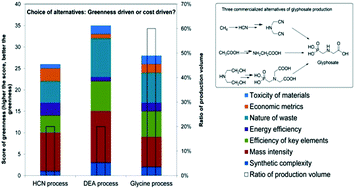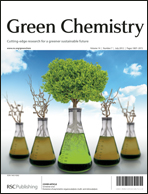Coupling mass balance analysis and multi-criteria ranking to assess the commercial-scale synthetic alternatives: a case study on glyphosate†
Abstract
Quantitative and systematical assessment of the greenness of synthetic alternatives is one of the key topics of green chemistry. By coupling mass balance analysis and multi-criteria decision analysis, the paper seeks to assess the greenness of three commercial-scale production processes of a broad spectrum herbicide named glyphosate on the basis of seven assessment criteria and sixteen metrics. The seven criteria include mass intensity, efficiency of four core elements (i.e., carbon, nitrogen, phosphorous, and chlorine), energy consumption, nature of the industrial waste, cost of raw materials, and toxicity of materials. The multi-criteria decision method is applied to rank the greenness of glyphosate's three synthetic alternatives in a comprehensive, aggregate manner. Our findings highlight the discrepancy between greenness-driven alternative and cost-driven alternative in fine chemical production. At present, the actual choice of glyphosate production process in China remains dominated by the economic criteria rather than a more comprehensive, balanced set of criteria spanning economic profitability, environmental soundness, and social responsibility. Nonetheless, the underlining research method is relevant to the choice of synthetic alternatives of other fine chemicals.


 Please wait while we load your content...
Please wait while we load your content...